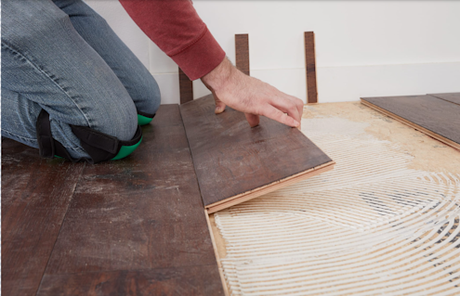Simply put: you do, dear reader. You care about interior design, or you wouldn't be here looking to update your space with premium flooring from Lumber Liquidators! And that's exactly the right mindset to have, you see, because interior design, goes well beyond your preconceptions of flowery terminology for ornamentation and drapery and provides a foundation of knowledge for planning, organizing, furnishing, and decorating the spaces within your home so that they are both functional and beautiful.
So, this means the keener your interior design eye, and the more you know about design in general, the more impressive you can make the end results of whichever home improvement projects you have in play. Once again, you wouldn't be going through the work of refreshing your floors with premium product from Lumber Liquidators if you didn't care about how impressive your new space is going to look; You want a home that reflects your personal style while also being a place where you can spend time peacefully and practically.
Thankfully, we know a lot about interior design here, and today, we're sharing some of that knowledge with you, so that you can get the perfect flooring to match your vision of the ideal home space…
Basic Interior Design Principles
You may have heard some conventional design wisdom along the lines of "great design breaks the rules." Generally speaking, this means that you don't need to feel constrained by trends or popular opinion in order to design a space that looks great, but you know what adherents of that simple maxim often fail to mention? You have to know the damned rules in the first place, and understand them, before you have any hope of knowing how to defy them effectively. Think of it like cooking. A chef who's mastered classical techniques can create incredible dishes by breaking traditional rules because they understand why those rules exist in the first place. But if you don't know the basics, your experimental dishes are more likely to be disasters than breakthroughs.
Learn the rules first, and not only will you have a solid foundation to follow when planning your home improvement projects, you'll know when and how to deviate from the beaten path in order to create a space that's a truly personal style statement. First things first, let's lay out the seven basic elements: space, shape/form, line, light, color, pattern, and texture.
Space
Space is the distance around and between adjacent pieces within a design, and can be classified into positive and negative space. Positive space indicates the position of objects within your design (the bed, sofa, chairs, dining table), and, yes, the area covered by your flooring as well. Meanwhile, negative space refers to the gaps between these objects, which is crucial for creating traffic paths for navigating the interior.
For most rooms in your home, you'll need to think about space in three dimensions: length, width, and height. You'll need to remember that the available space you have to work with in any given room is fixed (usually), so you have to plan your design within the physical boundaries of the space in question.
Your flooring choice, as it turns out, will play a massive role in how you perceive your space. Light-colored and wider-plank floors can make a rooms feel larger and more open, while darker and thinner floors can create a sense of intimacy and coziness. The direction you install plank flooring can also affect spatial perception, as running planks parallel to the longest wall can make a room feel longer, while installing them perpendicular can make a narrow space feel wider.
Shape/Form
Shape and Form are often used interchangeably to describe the contours of both your space and the objects within your space. Forms can be geometric, meaning they contain hard lines, square edges, and appear manufactured, or natural, meaning they have a more "organic" appearance that seems created by natural forces.
When it comes to flooring, this principle shows up in everything from the shape of your planks (narrow traditional strips versus wide contemporary boards) to the patterns created by different installation methods (herringbone, chevron, or straight plank installation). Solid hardwood naturally brings organic forms into your space through grain patterns and color variations, while luxury vinyl plank can offer either geometric precision or natural wood aesthetics depending on the specific product you choose.
Lines
Lines are the connections between any two points in your space, and how you use them will dramatically affect your perception of the space. Horizontal lines are created by tables, countertops, and—you guessed it—the edges of your flooring planks. These provide a sense of stability, formality, and efficiency, as they visually offset the direction of gravitational pull.
Vertical lines may be created by windows, doorways, built-in cabinetry, and even the grain patterns in your hardwood flooring. They often create the illusion of a room being taller and grander, which is why many designers recommend emphasizing vertical elements in rooms with lower ceilings.
Meanwhile, angular, curved, and dynamic lines play by their own rules, adding energy and excitement by mimicking movement. A swoosh here, a zig-zag there, and you can surely capture attention with your design. However, too many dynamic connections can distract, overpower, and dilute the visual power of your finished space.
Light
Light is essential to any space (we all like to be able to see our way around, no?) and when we're talking about interior design, we usually divide it into two categories: natural light and artificial light. For most designs, natural light is preferable, and we bring in artificial light when the amount of natural light a space receives is inadequate.
It's important to note, however, that including artificial light allows you to introduce specific color temperatures and play with features like dimmable switches, so you shouldn't dismiss it out of hand either. The interplay between natural and artificial light can create dramatic effects throughout different times of day.
Regardless of which you lean on, though, light in your space can be further broken down into three categories: task lighting, which exists to facilitate an activity or purpose; accent lighting, which emphasizes objects and elements within your design; and mood lighting, which adds ambiance to your space.
Your flooring choice significantly impacts how light behaves in your room. Lighter floors reflect more light, helping to brighten the entire space, while darker floors absorb light but can create rich, sophisticated atmospheres. The finish on your floors also matters, because high-gloss finishes can reflect more light but also create glare, while matte finishes provide a softer light distribution.
Color
Color is something you're already somewhat familiar with, most likely, and you may have even heard about concepts like color theory and color psychology used in relation to planning a space. Understanding color goes beyond just picking your favorite hue, though, as it's also about creating harmony and achieving specific emotional responses.
Colors can be warm (reds, oranges, yellows) or cool (blues, greens, purples), and they can dramatically affect how a space feels. Warm colors tend to make spaces feel cozier and more intimate, while cool colors can make rooms feel larger and more serene.
When choosing flooring, consider it as the foundation of your color scheme. Neutral-toned floors like natural oak or maple provide flexibility for changing wall colors and décor over time, while more dramatic choices like rich walnut or sleek gray can become the focal point of your color story.
Pattern
Pattern refers to repetition of forms, lines, or other design elements. Patterns help add character and personality to your space, but need to be used intentionally so as not to have them compete for attention. The forms patterns can take are quite broad, so they provide a great deal of latitude when trying to find one that matches your vision of the ideal interior space.
In flooring, pattern shows up in wood grain, plank arrangement, and installation direction. Some hardwood species have dramatic grain patterns that create natural visual interest, while others have subtle, uniform grains that serve as neutral backdrops. Installation patterns like herringbone or chevron add sophisticated geometric interest, while traditional straight-plank installation creates clean, linear patterns.
Texture
Can you see it? Can you feel it? That's Texture, the tactile surface of objects within your design. It applies both to the feeling of the objects when touched and the feeling it creates when observed (because texture can also be visual). Texture adds depth and dimension to your space, helps create contrasts, and, when used properly, helps a room feel dynamic without becoming uncomfortable or overwhelming.
Flooring offers incredible opportunities to introduce texture. Hand-scraped hardwood provides rustic, tactile texture that you can both see and feel underfoot. Smooth, polished surfaces create sleek, contemporary texture. Even luxury vinyl plank now offers realistic textures that mimic everything from weathered barn wood to smooth stone.
Principles in Practice: Using Interior Design Elements Together
Now that we've covered the individual elements, let's talk about how to start thinking about these interior design principles and putting them into practice in unison. The magic happens when different elements enhance one another and work together to create cohesive visual effects within your space.
Consider how space and light work together: a small room with dark flooring might feel cramped in poor lighting conditions, but introduce plenty of natural light and some strategic artificial lighting, and that same dark floor can create a sophisticated, intimate atmosphere without feeling claustrophobic.
Think about how color and texture can complement each other: a cool-toned gray hardwood floor might feel stark on its own, but add warm-toned wood furniture and soft textiles, and you create a balanced, inviting space that feels both contemporary and comfortable.
Pattern and line relationships are crucial too. If you have strong horizontal lines in your furniture and window treatments, consider how the linear pattern of straight-plank flooring installation will either reinforce that horizontal emphasis or how a herringbone pattern might add visual interest without competing.
The key is balance. You want enough variety to create interest, but not so much that elements fight for attention. Your flooring, covering the largest surface area in your room, serves as the foundation that either supports or undermines every other design decision you make.
Popular Interior Design Styles and Perfect Flooring Matches
"Art Deco," "Mid-Century Modern," "Industrial" — ever heard any of these terms before? Interior design styles are numerous, and though we can't cover them all here today, we can go over a strong sampling of diverse and popular looks so that you can learn more about what speaks to you and which types of flooring fit the bill, then get inspired to discover even more styles.
Art Deco
Born in the 1920s and 1930s, Art Deco embraces luxury, glamour, and bold geometric patterns. This style features rich materials, metallic accents, and dramatic contrasts. For flooring, Art Deco spaces shine with dark, polished hardwoods like walnut or ebony-stained oak. The high-gloss finish reflects light dramatically, creating the sophisticated elegance this style demands. Geometric installation patterns like herringbone or chevron perfectly complement Art Deco's love of angular designs. 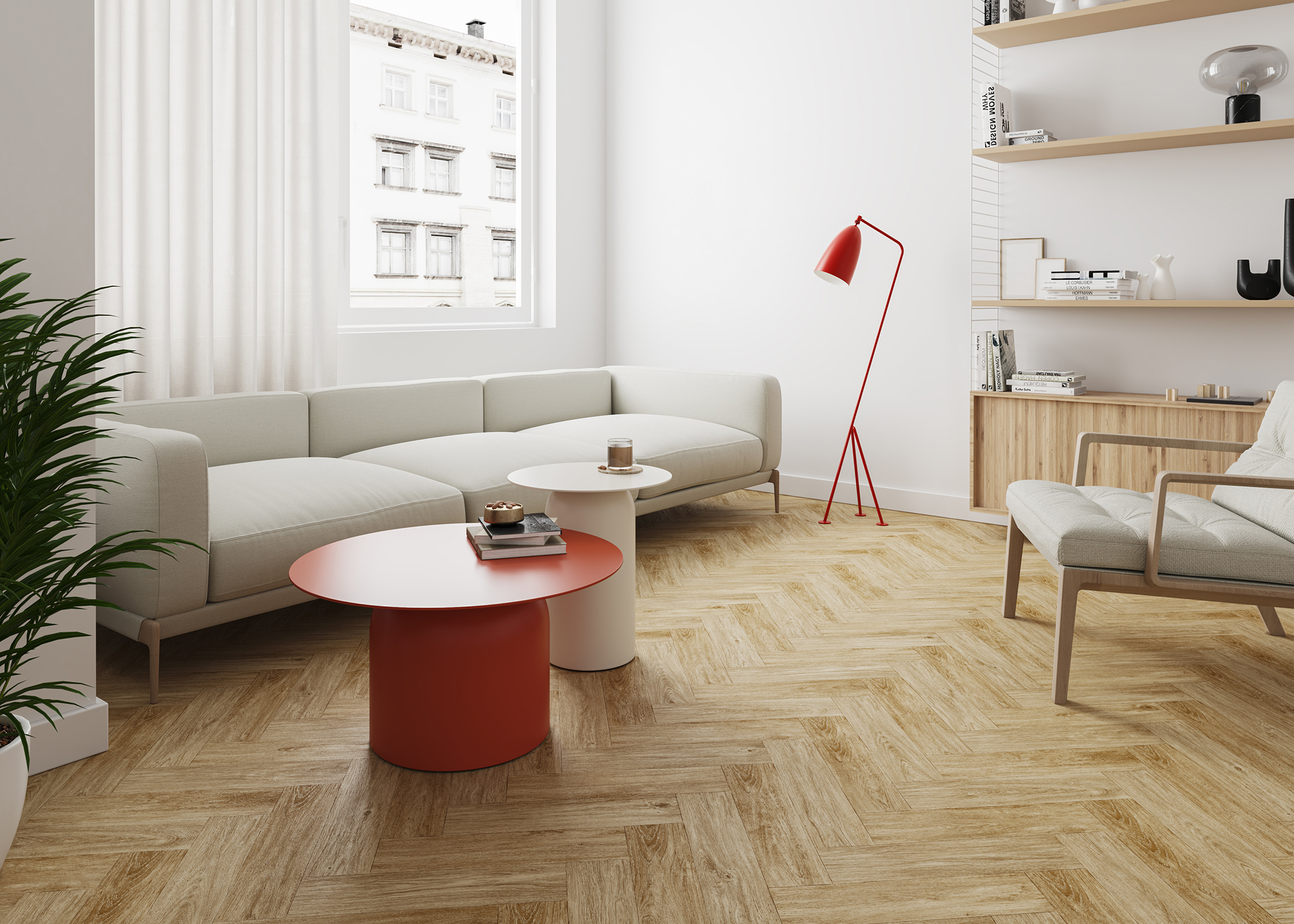
Our Malibu Herringbone water-resistant laminate flooring effortlessly captures the essence of Art Deco with luxurious, geometric allure. Its bold herringbone pattern, a hallmark of the style, brings ample angular symmetry for dramatic visual impact, and the interplay of tan and tawny tones (enhanced by that realistic wood graining) mirrors the rich, layered aesthetics so typical of this design movement.
Bohemian
Bohemian style embraces variety, mixing textures, colors, and patterns from around the world. This relaxed, artistic approach values personal expression over conventional rules. For Boho spaces, consider warm-toned hardwoods with rich grain patterns like hickory or hand-scraped oak. These floors provide organic texture and warmth that serve as perfect foundations for layered rugs, diverse furniture, and collected treasures from travels and adventures. 
The vibrant blondes, browns, and tans of our Matte Hickory Natural solid hardwood flooring create a complex color base that complements the the layered aesthetic of Bohemian style. A smooth matte finish enhances the organic grain of this hardwood, adding depth to your space, and allows the bold colors and patterns of this floor to shine without overpowering other elements of your design.
Coastal
Coastal design captures the breezy, relaxed feeling of oceanside living through light colors, natural textures, and casual elegance. Light-colored flooring is essential—think white oak, ash, or maple engineered hardwood that mimics driftwood. These floors reflect natural light beautifully and create the airy, open feel that defines coastal style. Waterproof vinyl plank in light wood tones works excellently in coastal kitchens and bathrooms where moisture might be a concern. 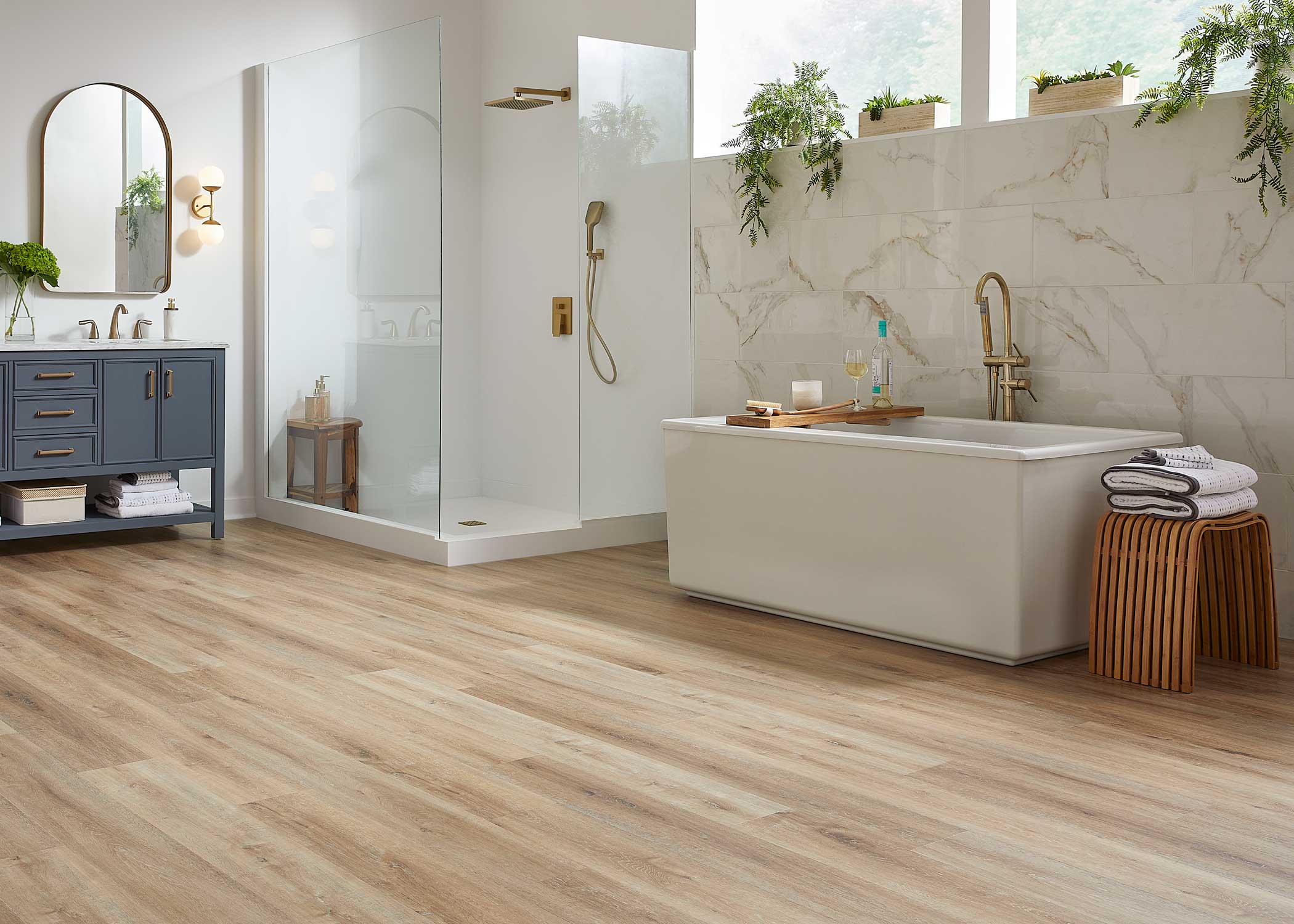
With a slightly distressed grain pattern and soft brown hues, our Island Oak rigid vinyl plank flooring captures the natural essence of driftwood upon sun-kissed shores -- a perfect embodiment of Coastal charm. The light color palette helps reflect natural light, which, combined with the 7-inch width of these planks, enhances the sense of openness in your space and rounds out any light, airy aesthetic.
Eclectic
Eclectic design celebrates mixing different periods, styles, and influences to create spaces that feel collected over time rather than designed all at once. The key is having a unifying thread (often color or texture) that ties diverse elements together. For eclectic spaces, versatile flooring options work best. Medium-toned hardwoods like natural oak or hickory provide neutral foundations that can support everything from vintage Persian rugs to contemporary art. Engineered hardwood offers the flexibility to work with various furniture heights and styles while maintaining visual coherence. 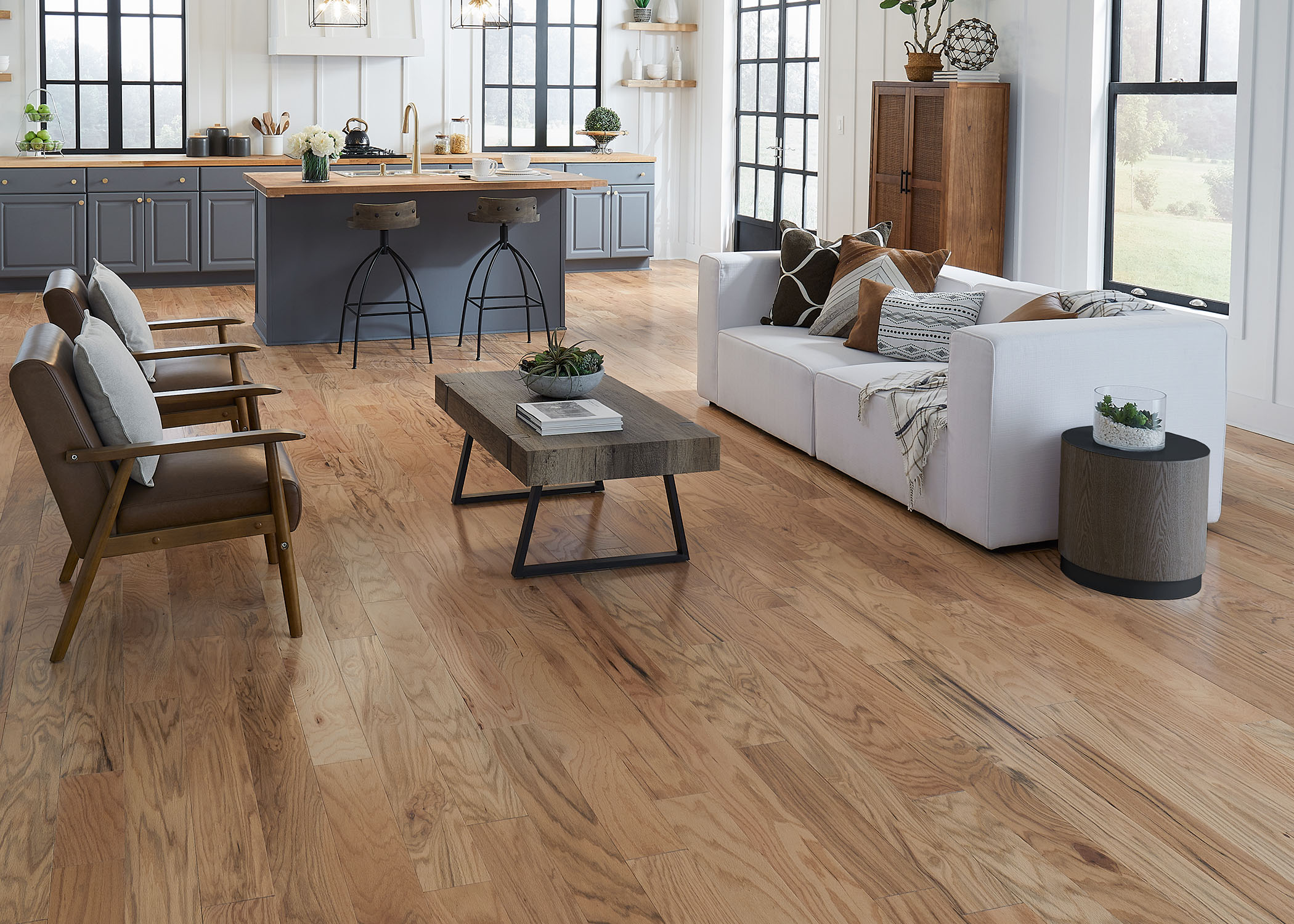
Our Red Oak Natural engineered hardwood flooring allows Eclectic interior design to thrive, providing a visually dynamic backdrop that complements diverse stylistic elements. From antique textiles to contemporary art, this floor adds punch with emphatic red oak hues and natural grain patterns, and supports bold style choices while maintaining foundational balance.
Farmhouse
Modern farmhouse style combines the warmth and character of rural living with contemporary functionality. This style emphasizes natural materials, vintage elements, and comfortable, lived-in appeal. Wide-plank hardwood floors with visible grain patterns and rustic textures are perfect here. Consider hand-scraped or wire-brushed oak, hickory, or reclaimed-look engineered hardwood. These floors should look like they have stories to tell and can handle the demands of family life. 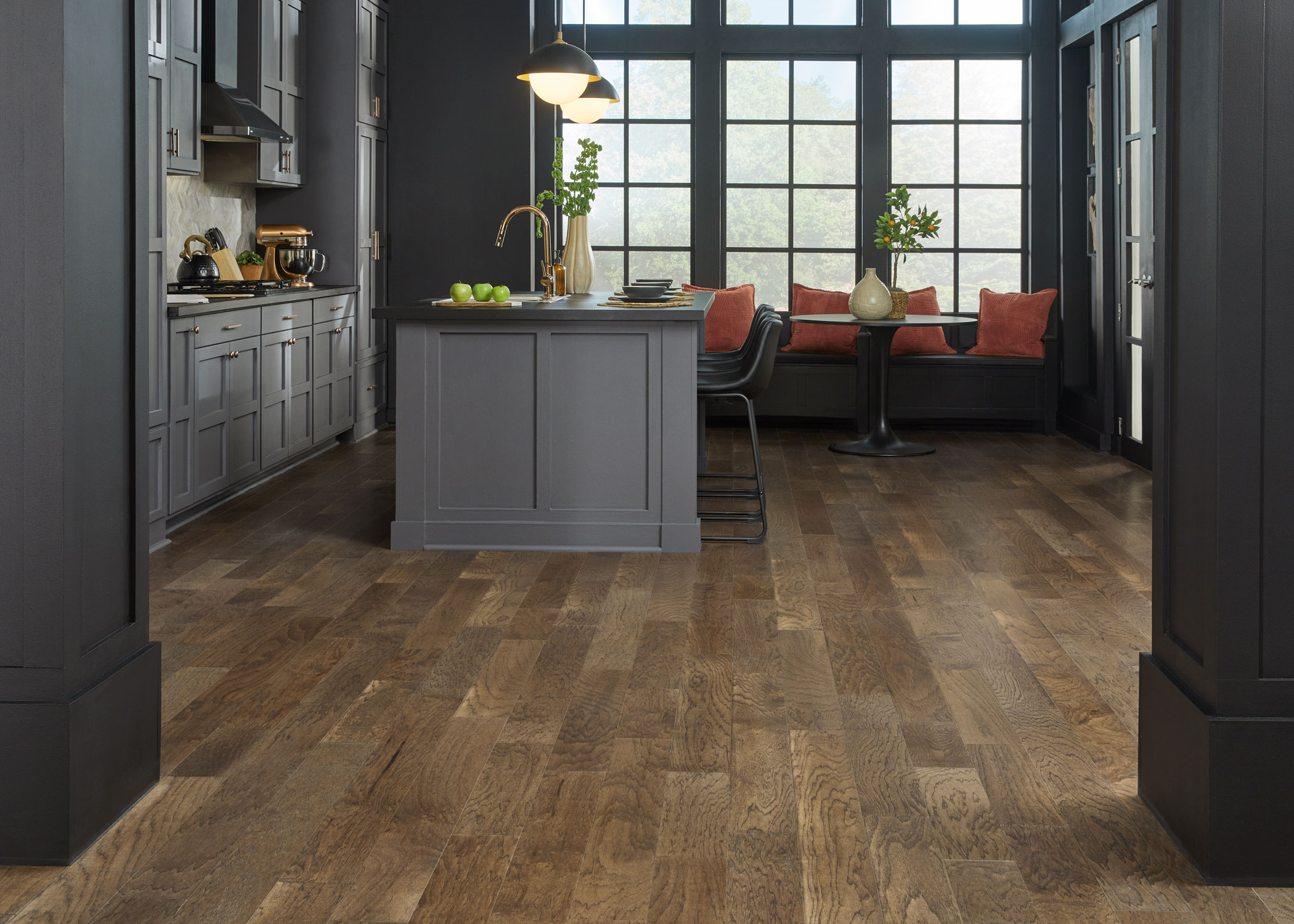
A deep, earthy tone and varied character markings give our Shadow Valley Hickory engineered hardwood flooring a handcrafted look that fits seamlessly into the farmhouse ethos of authenticity and comfort. These dark hues create a foundation that complements distressed furniture and woven textiles while adding a touch of refinement that evokes the warmth of rural living.
French Country
French Country style combines rustic charm with refined elegance, drawing inspiration from provincial French farmhouses and châteaux. This style emphasizes natural materials, soft colors, and graceful curves alongside weathered textures. For authentic French Country appeal, choose wide-plank hardwood floors with character marks like knots, grain variation, and hand-scraped textures. Light to medium oak tones work beautifully, as do hickory and reclaimed-look engineered options that capture the time-worn elegance this style celebrates. 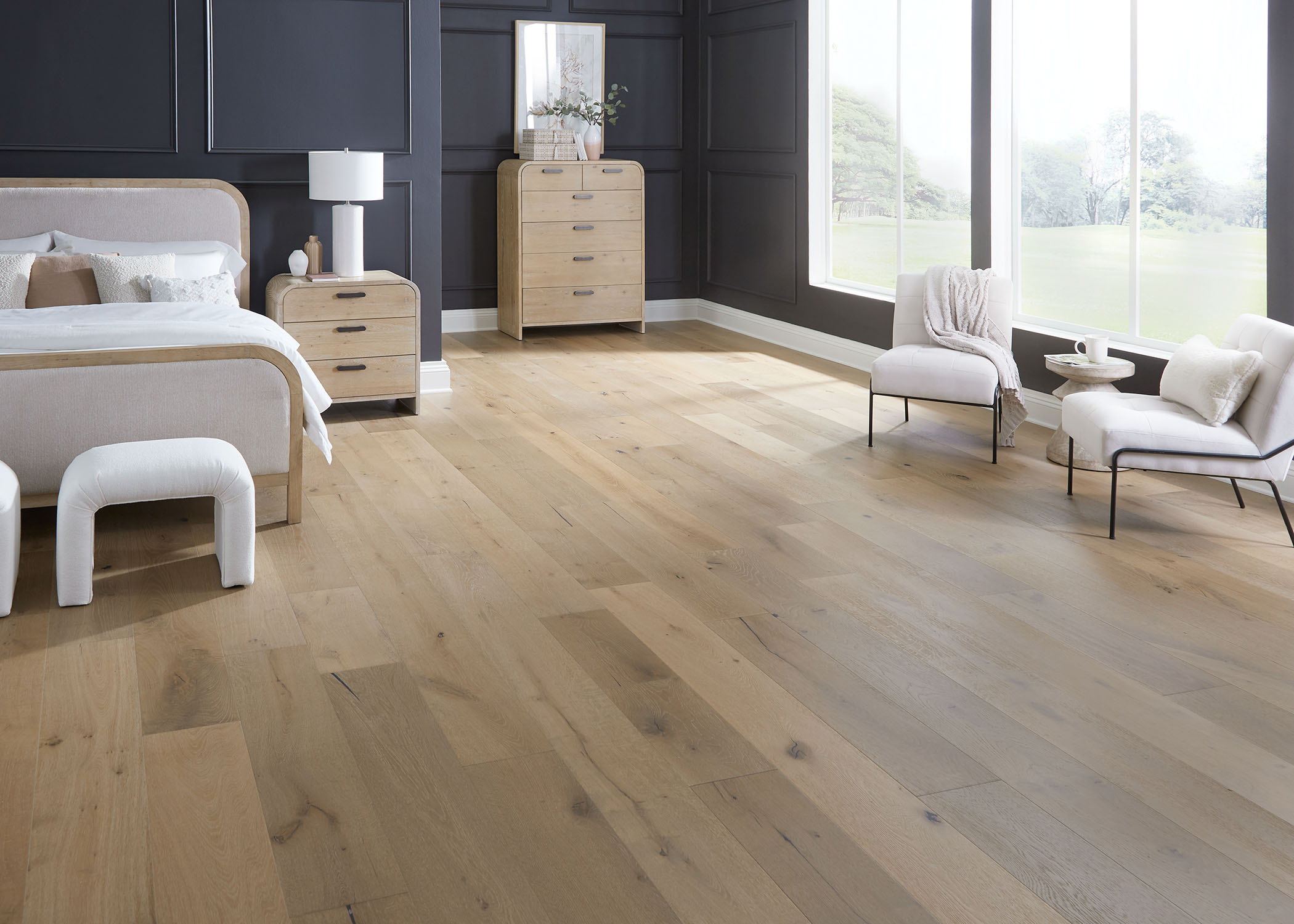
A natural aesthetic with distressed textures allows our Tarpon Bay White Oak engineered hardwood flooring to mirror the rustic elegance of French provincial farmhouses and châteaux living. 9.5-inch wide planks bring a sense of grandeur and openness to any room (a hallmark of the style), and the balanced brown hues of this floor feel right at home in any wood-furnished, linen-curtained, and wrought-iron-accented spaces.
Hollywood Regency
Born in the 1930s Golden Age of Hollywood, this style embraces theatrical glamour, bold contrasts, and luxurious materials. Hollywood Regency is all about making a statement through dramatic lighting, metallic accents, and rich textures. For flooring, think high-drama options: dark walnut or ebony-stained hardwood with high-gloss finishes that reflect light like a movie set. These floors should feel like red carpet moments, providing the perfect backdrop for statement furniture and dramatic décor. 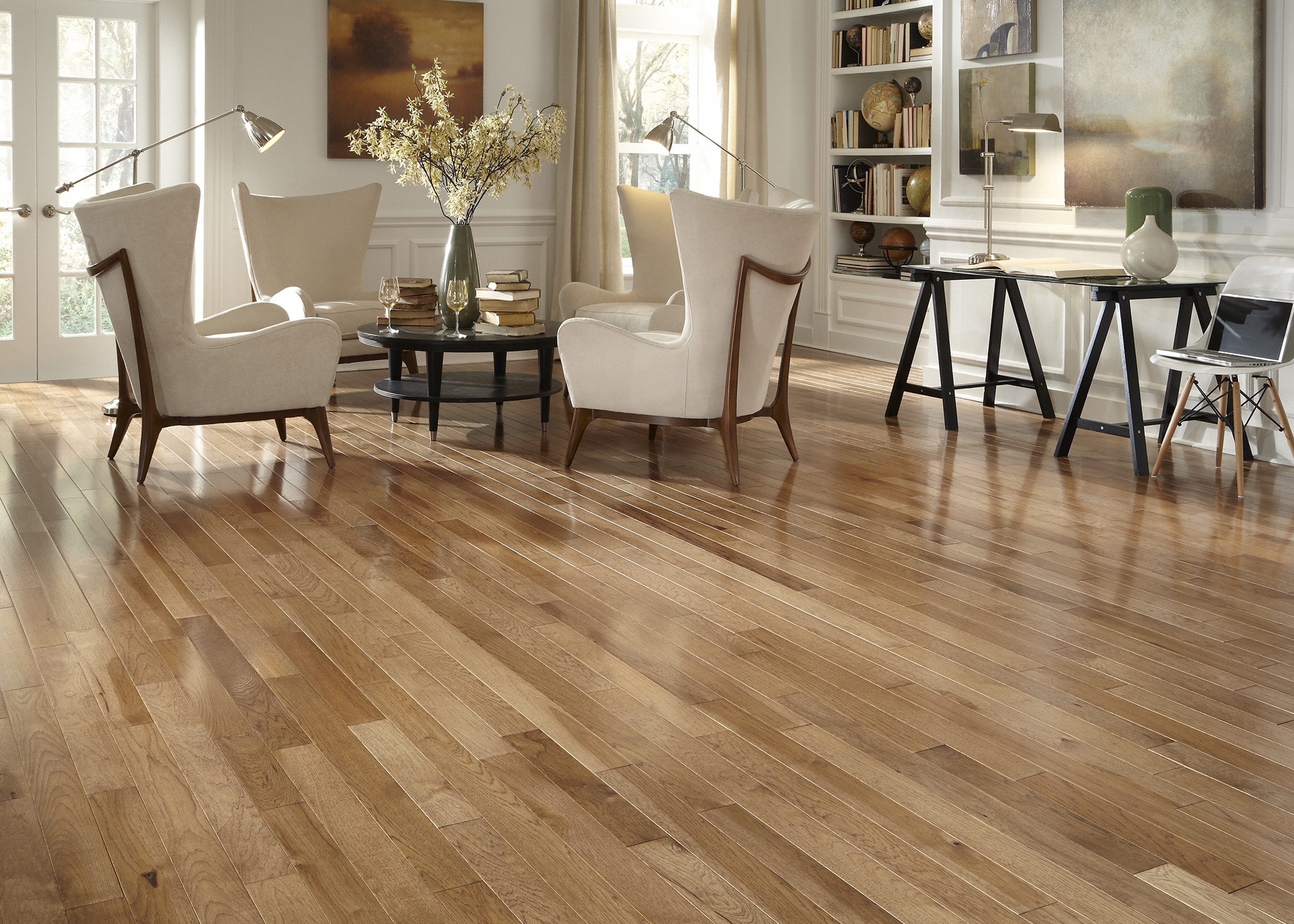
Hollywood Regency emphasizes the dramatic, and our Walnut Hickory solid hardwood flooring sets the stage for theatrics with bold hues beautiful character marks fit for a movie set. Sophisticated statement pieces stand out atop this rich walnut hickory, so go wild with velvet drapes, chrome fixtures, and those crystal chandeliers you haven't used since that 1920s-themed New Year's Eve party.
Industrial
Industrial design draws inspiration from factories and urban lofts, emphasizing raw materials, exposed structural elements, and utilitarian aesthetics. For flooring, think about materials that complement concrete, steel, and brick. Dark-stained hardwood, particularly with matte finishes, works beautifully. Alternatively, luxury vinyl plank in concrete or stone looks can provide the perfect industrial foundation while offering practical benefits for modern living. 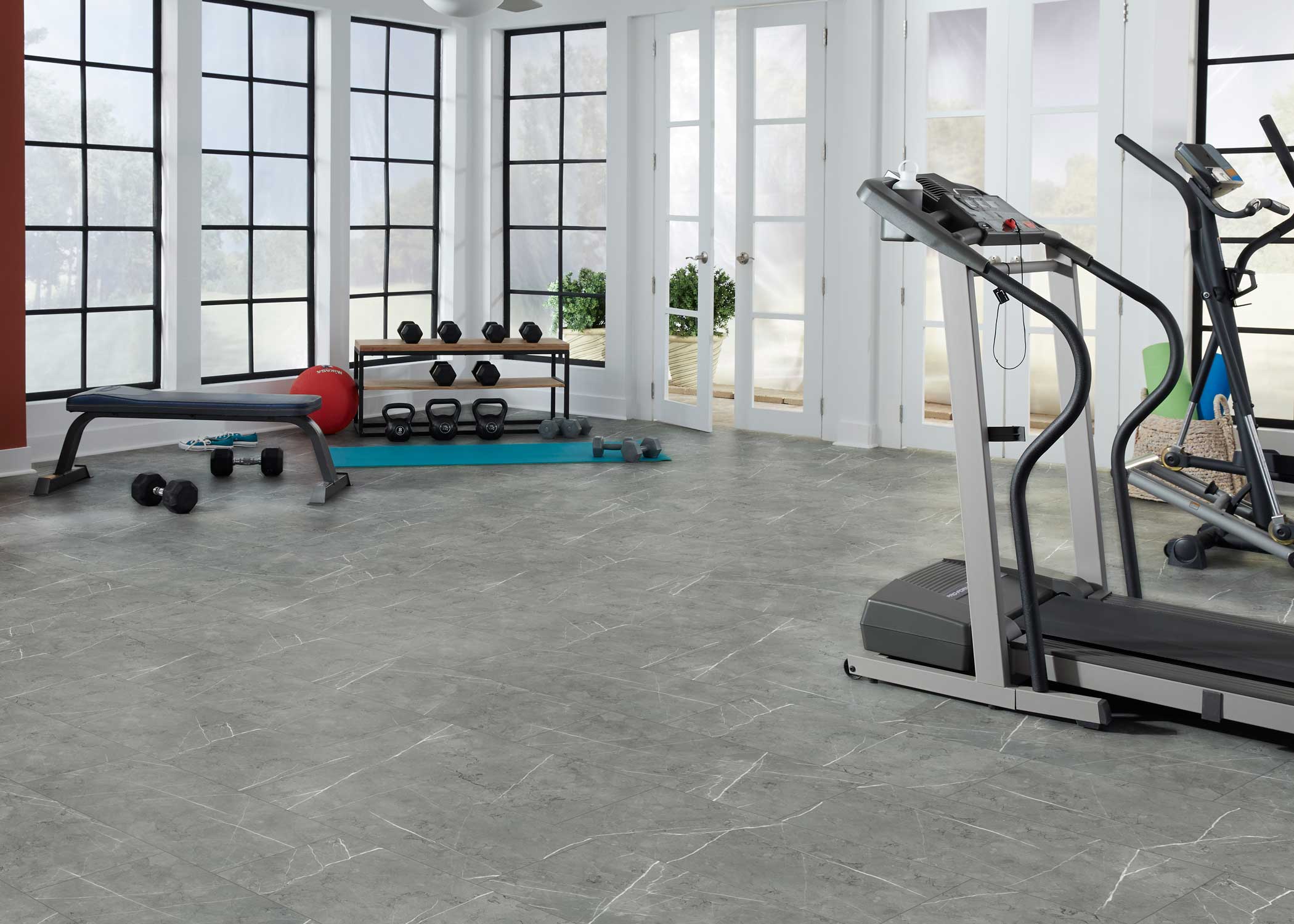
The sophisticated stone look of our Grigio Salerno rigid vinyl tile brings a cool neutrality that enhances Industrial vibe with simple, unadorned character. Muted gray hues serve as a celebration of the utilitarian ethos behind Industrial style, and provide a versatile canvas for you to experiment with metal accents, exposed beams, brick walls, and other raw structural elements.
Japandi
Japandi combines Japanese minimalism with Scandinavian coziness, creating spaces that feel both serene and welcoming. This style emphasizes natural materials, neutral colors, and uncluttered spaces that promote tranquility. For Japandi interiors, choose light-colored hardwoods with minimal grain variation (white oak, ash, or light maple work perfectly). Floors should have matte or low-sheen finishes that feel natural and understated, supporting the style's emphasis on simplicity and connection to nature. 
Simple, cozy, inviting -- the look of our Maple Select solid hardwood flooring perfectly embodies Japandi design principles. With a plain palette and smooth surface, these planks exemplify simplicty, and create an outstanding foundation upon which you can foster tranquility and experiment with plants, soft textiles, and other harmonious design elements.
Maximalist
Maximalist design embraces abundance, mixing bold patterns, rich colors, and diverse textures to create spaces that feel vibrant and collected. This style celebrates personality over restraint, layering elements to create visually rich environments. For maximalist spaces, your flooring needs to hold its own without competing with everything else. Exotic hardwoods, along with rich, dark hardwoods like walnut or mahogany provide grounding foundations that can support bold rugs, dramatic wallpaper, and eclectic furniture collections. 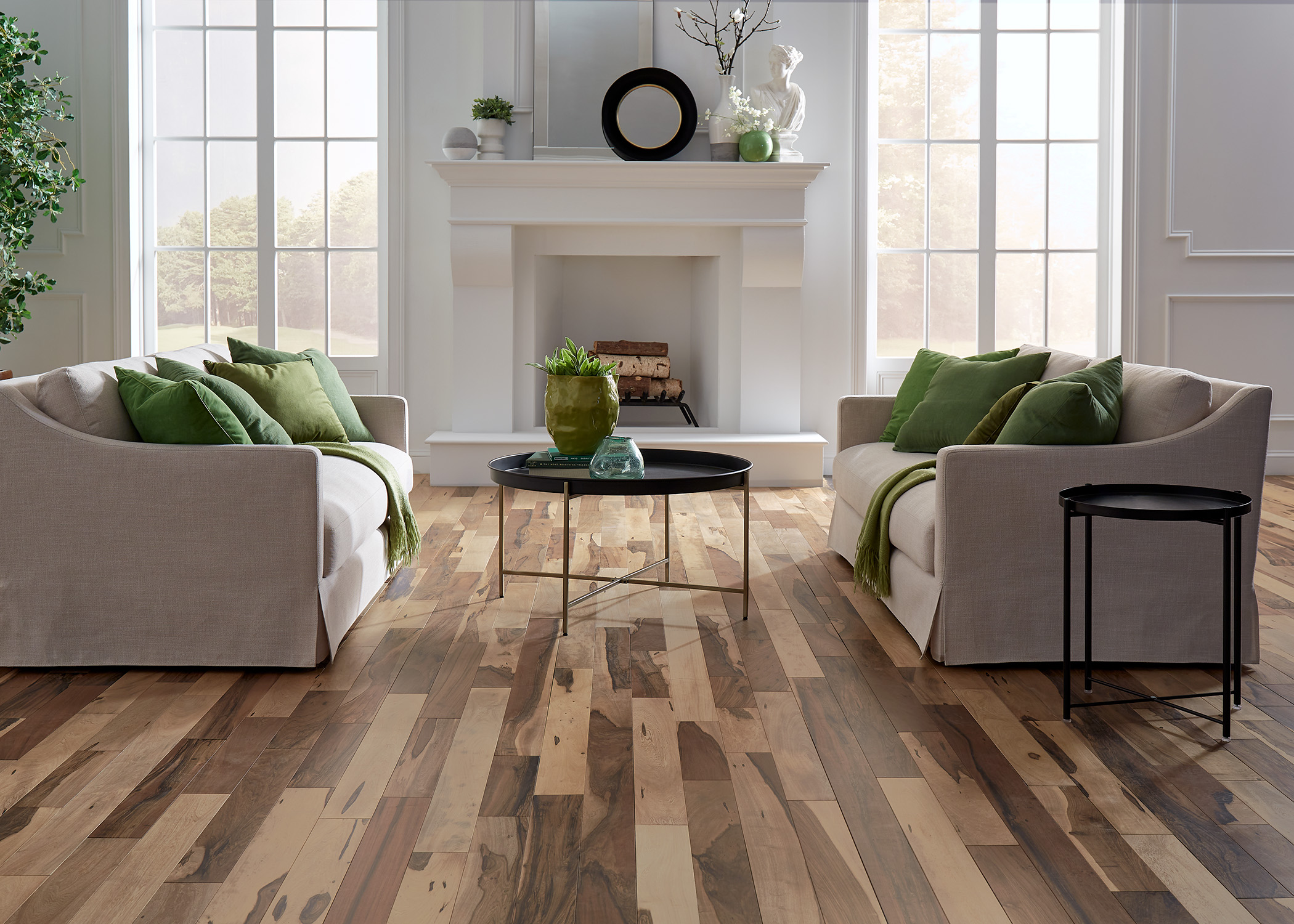
When it comes to making an emphatic statement, few floors are as forceful as our Brazilian Pecan Natural solid hardwood. This exotic hardwood species features rich, varied hues that complement the maximalist desire for depth, character, and grandeur, along with smooth-yet-textured matte finish that meshes well with dramatic rugs, bold statement art, and layered textiles.
Mediterranean
Mediterranean design draws inspiration from the coastal regions of Spain, Italy, and Greece, emphasizing warm colors, natural materials, and indoor-outdoor living. This style features earth tones, textured surfaces, and rustic elegance. For Mediterranean spaces, consider warm-toned hardwoods with rich grain patterns (hickory, acacia, or hand-scraped oak capture the sun-weathered beauty this style celebrates). These floors should feel like they've been kissed by sunshine, providing warmth and character that complements wrought iron, natural stone, and terra cotta accents. 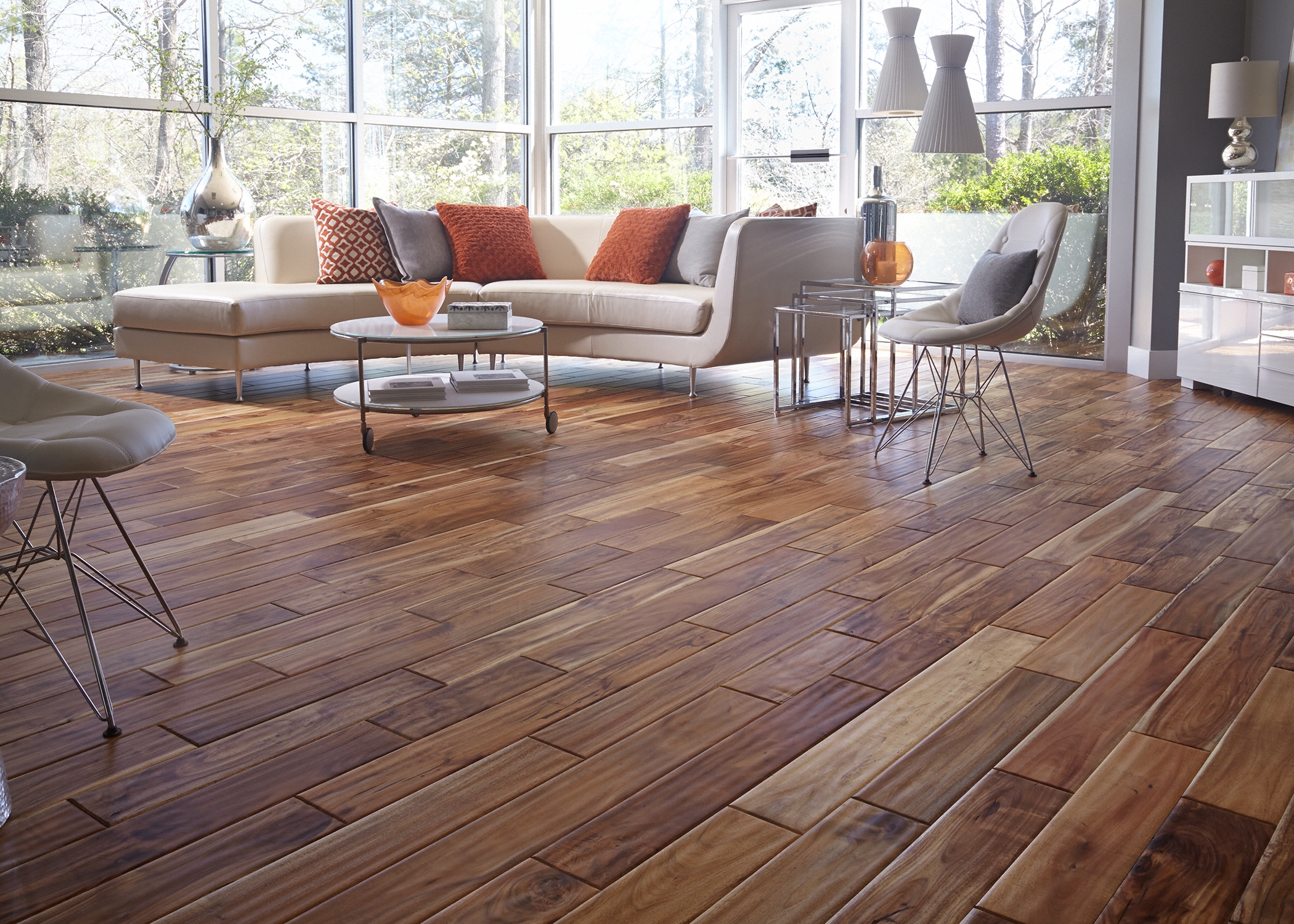
With bold colors and beaming warmth, our Tobacco Road Acacia solid hardwood flooring brings rich character that's emblematic of Mediterranean style. Its hues evoke the essence of Spain, Italy, and Greece, while each plank hosts organic character markings that effortlessly accompany metallic fixtures, natural stone countertops, terra cotta tiles, and other natural design elements.
Mid-Century Modern
Emerging in the 1940s-1960s, Mid-Century Modern design emphasizes clean lines, minimal ornamentation, and integration with nature. This style celebrates natural wood grains and typically features warm-toned species like walnut, teak, or cherry. For authentic Mid-Century appeal, choose hardwood floors with rich, clear grain patterns and warm honey to chocolate brown tones. The floors should be smooth and sleek, emphasizing the natural beauty of the wood itself. 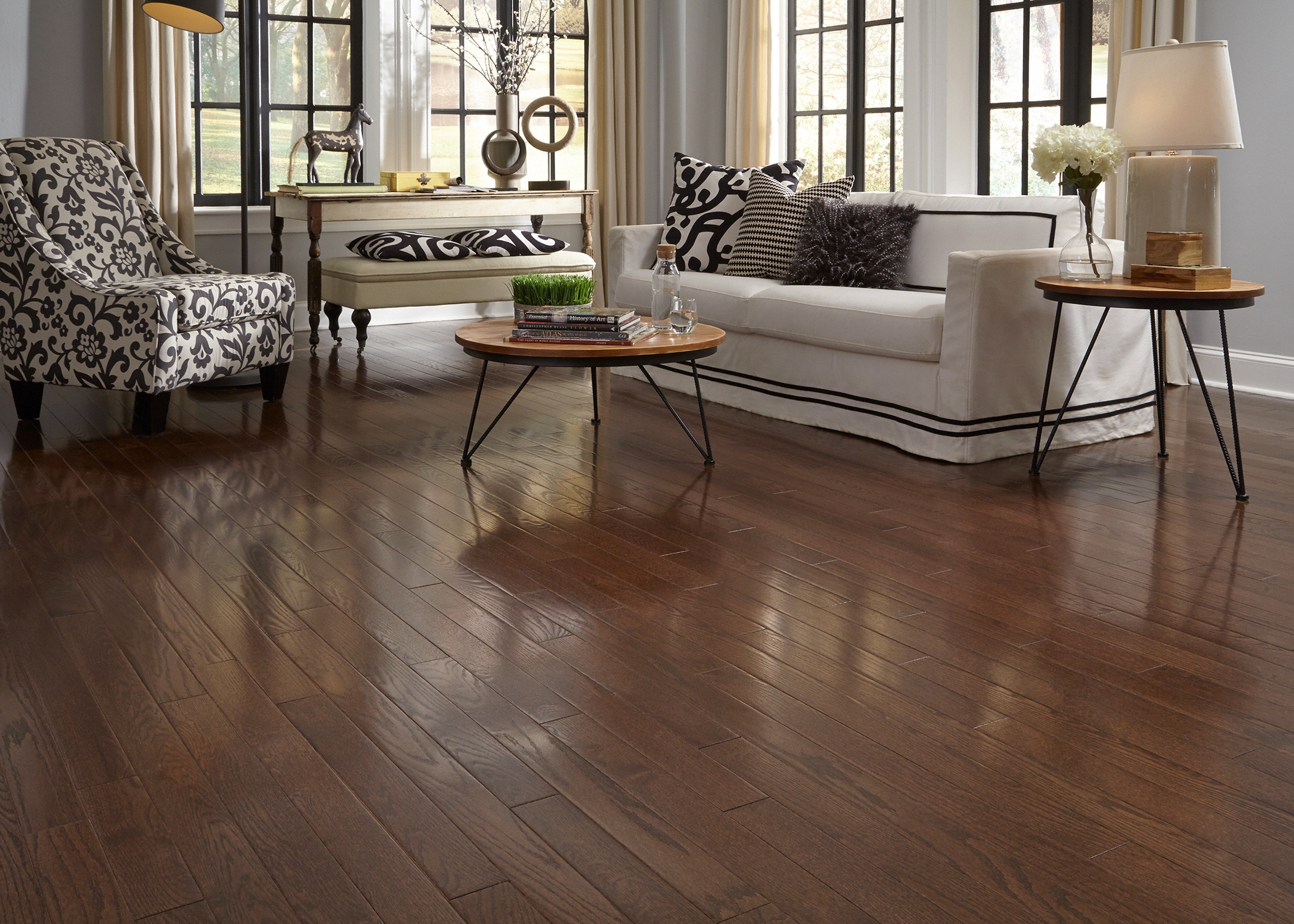
Mid-Century Modern style favors earthy tones, and the deep dark brown of our Mocha Oak solid hardwood flooring fits the bill perfectly. Gaze into this floor's robust hues long enough, and you'll also notice rich character markings and wood grain that add to its refinement and make it easy to imagine Mocha Oak as the foundation to your living room, game room, or lounge.
Minimalist
Minimalist design strips away the unnecessary to focus on essential elements, clean lines, and serene simplicity. Flooring in minimalist spaces should be understated yet high-quality. Light-colored hardwoods like maple or white oak with minimal grain variation work perfectly. The goal is flooring that provides a clean, neutral foundation without competing for attention. Engineered hardwood in extra-wide planks can create the seamless, uninterrupted surfaces that minimalist design craves. 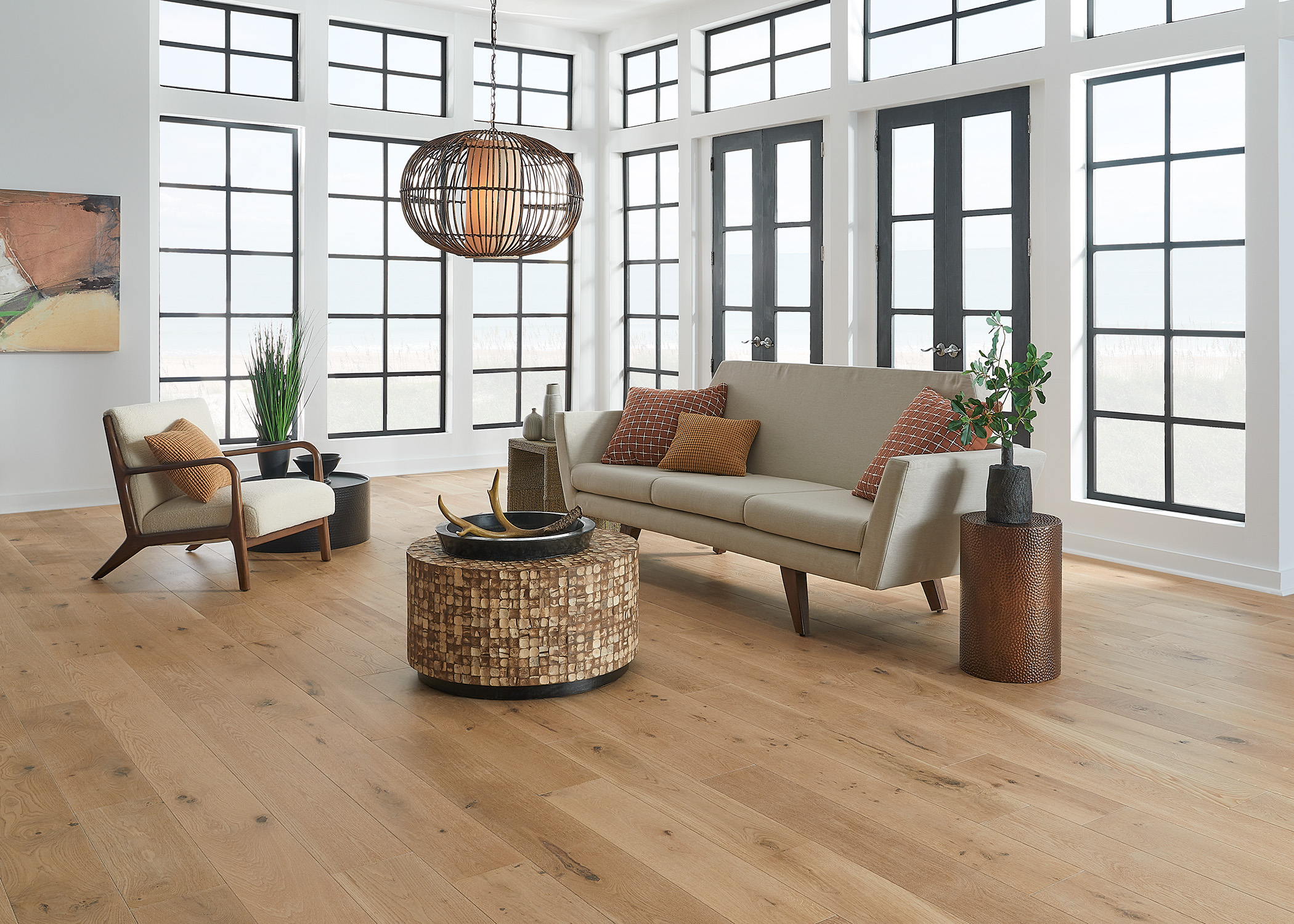
When style simplicity is the goal, our Amsterdam White Oak engineered hardwood flooring provides the clean lines and neutral hues that allow you focus your design thusly. With 7.5-inch-wide planks sporting a clean, uninterrupted look, you'll be well-positioned to keep visual clutter to a minimum within your space and avoid multiple elements vying for attention.
Rustic
Rustic design celebrates the beauty of natural materials in their most authentic forms, emphasizing texture, character marks, and the passage of time. This style values substance over perfection, creating spaces that feel connected to nature and craftsmanship traditions. For rustic interiors, choose hardwood floors with maximum character (hand-scraped oak, wire-brushed hickory, or reclaimed-looking options with knots, grain variation, and weathered textures). These floors should tell stories and feel like they've lived full lives. 
Our Winter Solstice Hickory solid hardwood flooring creates a strong base for rustic spaces with its bold brown hue and wire-brushed textures. In addition to being one of the stronger hardwood species, this floor's tactile, organic quality fits well within that Rustic ethos of "handcrafted" and "resilient", helping establish a "lived-in" feel within your space that's simultaneously sturdy.
Traditional
Traditional design draws from classic European styles, emphasizing formal symmetry, rich materials, and refined details. For traditional spaces, classic hardwood species like oak, maple, or cherry in medium to dark stains provide the perfect foundation. These floors should have elegant grain patterns and polished finishes that reflect the room's formal lighting and sophisticated furnishings. 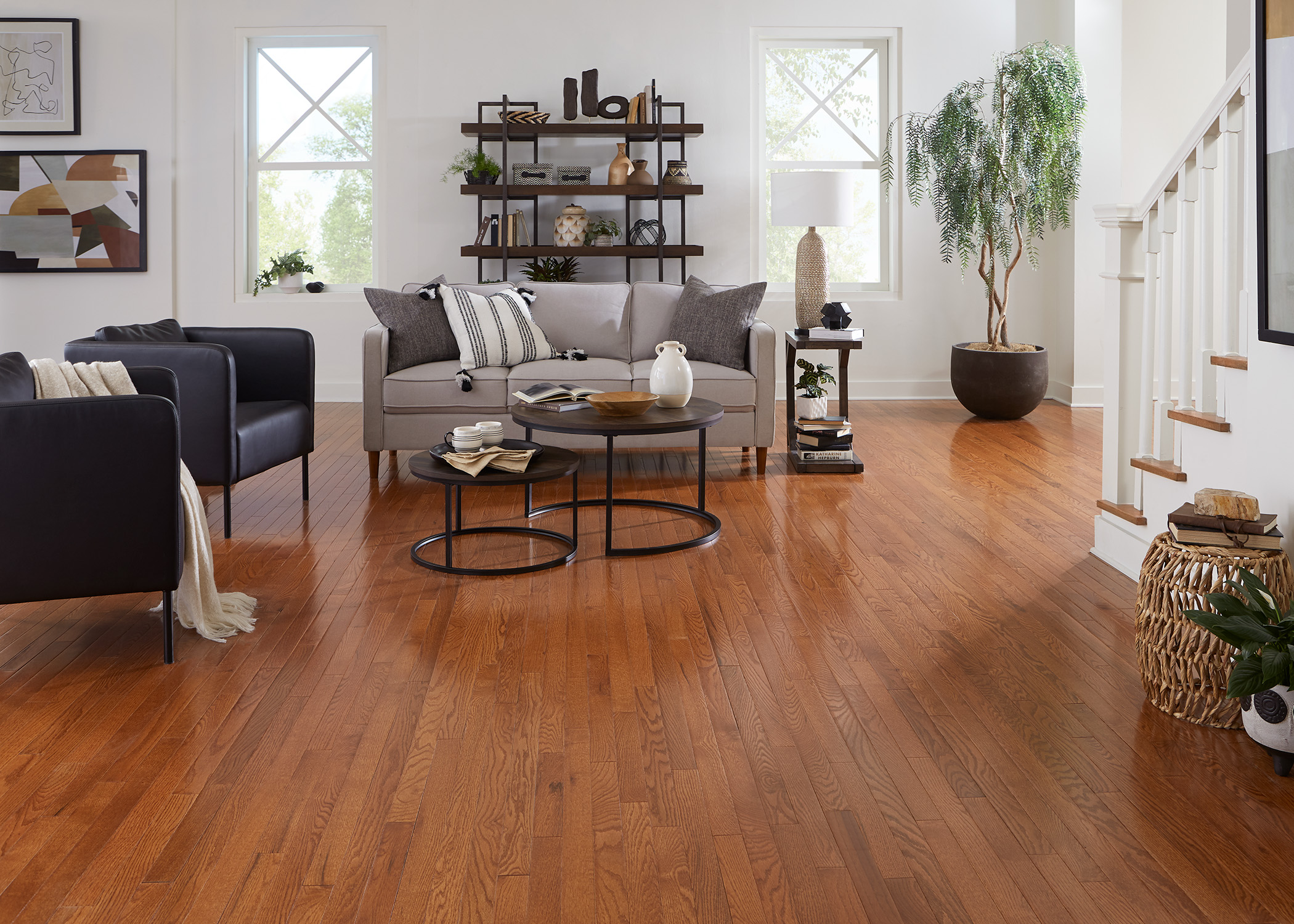
Few looks are as timeless as our Classic Gunstock Oak solid hardwood flooring. It's the embodiment of Traditional, with a rich hue, elegant grain patterns, and smooth textures that offer an enduring complement to formal lighting, sophisticated furnishings, and other hallmarks of Traditional interior design.
TIP TIME: Each of these styles offers its own interpretation of beauty and functionality, but understanding their fundamental characteristics helps you choose flooring that supports rather than fights your overall design vision. Remember, your floors will likely outlast several furniture and décor changes, so choosing a style-appropriate foundation gives you flexibility to evolve your space over time.
Next Steps: Putting Your Design Knowledge to Work
Now that you've got a solid foundation in interior design principles and popular styles, it's time to put this knowledge to work in planning your next project! Understanding these concepts means you can approach your flooring decision with confidence, knowing that your choice will support your overall design goals rather than working against them.
Don't feel like you need to become an expert overnight, though. Great design is often the result of thoughtful decisions made one at a time, each building on the last to create something cohesive and personal. Your flooring choice is one of the most important decisions you'll be making here, since it affects every other element in your room; it makes sense to evaluate your options to ensure the right choice!
And remember that Lumber Liquidators has all your flooring needs covered! From design advice to ordering product to scheduling installation, we can hook you up with everything you need to transform your space. Our flooring experts understand how different materials work with various design styles, and we're here to help you find the perfect flooring solution for your vision and lifestyle.
Our extensive selection includes solid hardwood, engineered hardwood, luxury vinyl plank, laminate, and hybrid resilient flooring options to suit every style preference and practical requirement. So, no matter what you're drawn to, we have the products and expertise to help you create the space of your dreams.
Ready to get started? Visit your local Lumber Liquidators store or browse our selection here online to explore the possibilities. Take home samples of your top choices, speak with our flooring experts, and start turning your design vision into reality.




